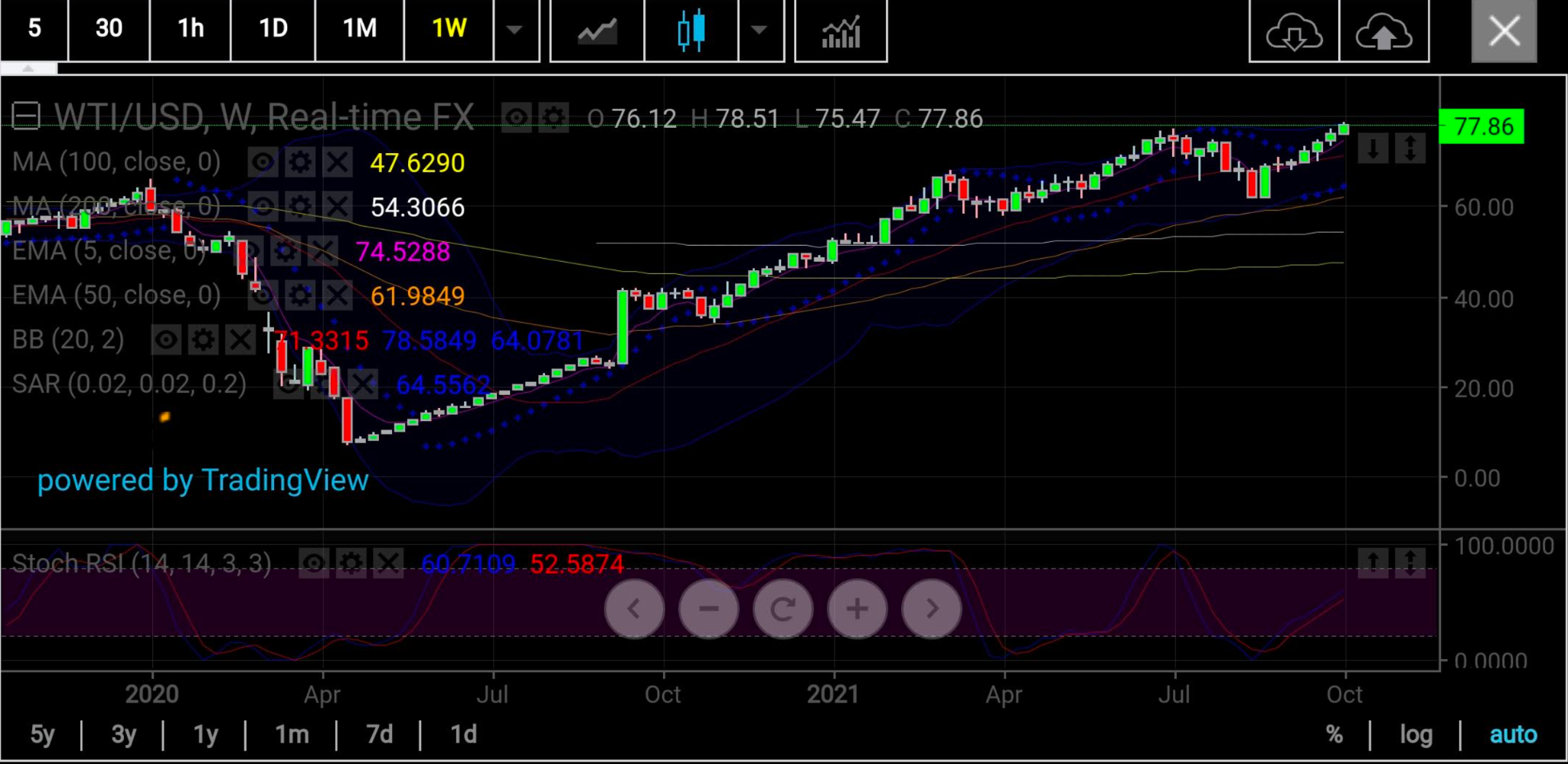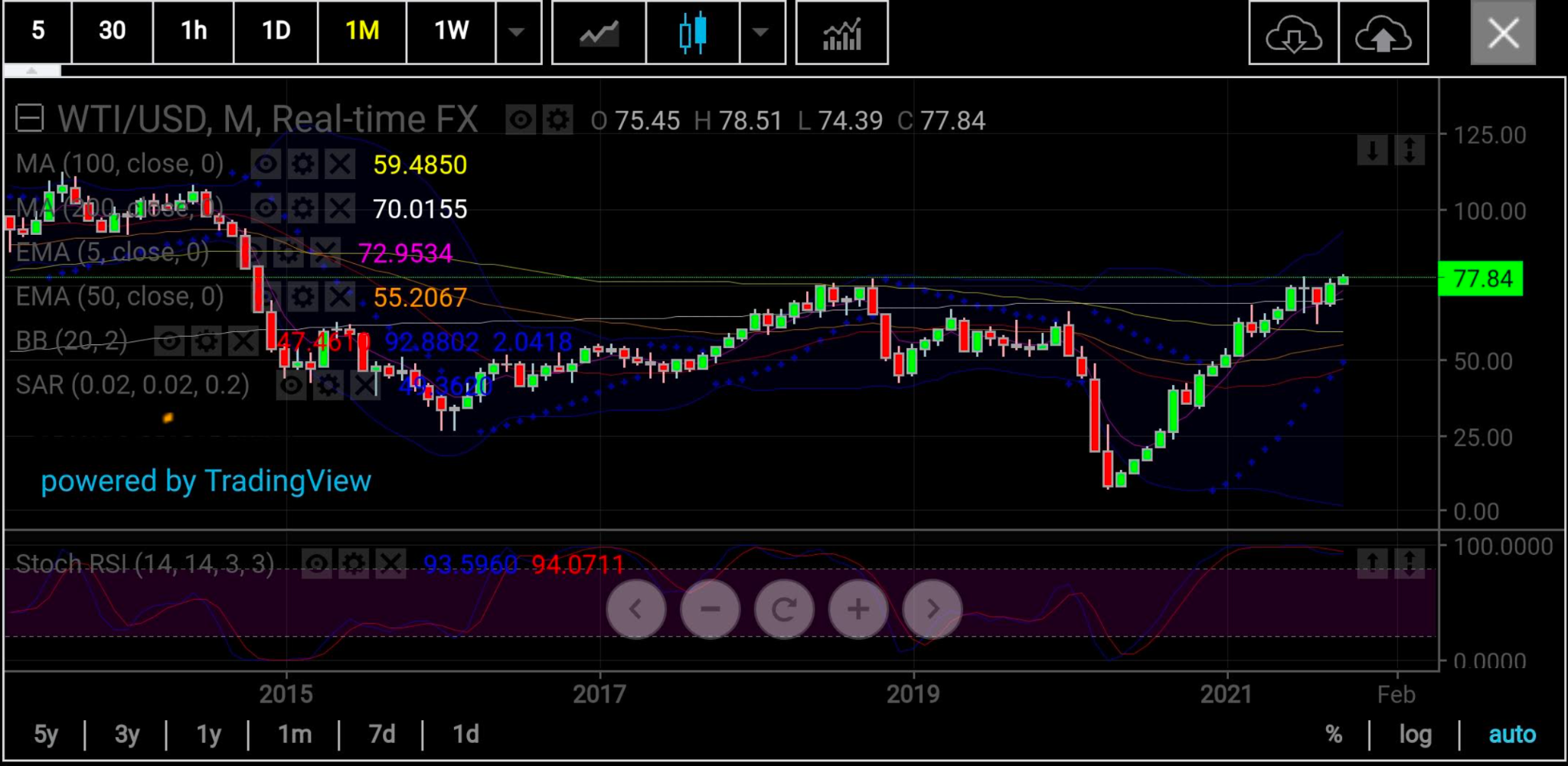It’s already up about 60% or more on the year, and all indications are that it’s massively overbought and due to correct. Yet, like anything where its implied demand attracts more attention than its actual use, oil prices are expected to continue rising.
This is especially after Monday’s move by OPEC+ to reject any notion of adding more supply than it has committed to a market of which it was in absolute control. Prior to Monday’s meeting of the 23-nation oil producing alliance, there had been speculation it might agree to adding beyond the 400,000 barrels per day of new supply it had committed to through end-April.
But once the video linkup was over among the 13-member Saudi-led Organization of the Petroleum Exporting Countries and their 10 allies steered by Russia, the message was clear: there would be no change.
There was no official statement on the matter either. But a Saudi official told the Wall Street Journal that “the kingdom is comfortable with the current price range and feels it won’t weigh on demand for oil.”

All charts courtesy of SK Charting
Filling in the blanks were more off-the-record comments from OPEC+ delegates. One who actually told Reuters:
"We are scared of the fourth wave of corona; no one wants to make any big moves.”
That sounds like a tinge of drama given the flat-lining caseloads for the Delta variant over the past few weeks and OPEC+’s monthly (or as-required) virtual meetings that allows the group to pull back production whenever necessary.
The alliance’s virtually unchallenged hold on supply-demand is another reason that allows OPEC+ to do as it pleases. The “Drill baby, Drill!” battle cry associated with the American oil industry has vanished and in its place are drilling companies that are more risk-averse than ever in the seven years that shale oil became a global phenomenon.
The once freely-spouting Permian and Bakken oil basins of America are producing way-below capacity as drillers try to please their shareholders with dividends instead of frustrating them with losses like before. It’s fair to say the industry’s new maxim is: if it ain’t broken, don’t fix it (i.e., if OPEC has control of the market, don’t be a hero trying to challenge it).
As Scott Sheffield, who heads US oil driller Pioneer Natural Resources (NYSE:PXD), told the Financial Times last week:
“Everybody’s going to be disciplined, regardless whether it’s $75 Brent, $80 Brent, or $100 Brent. All the shareholders that I’ve talked to said that if anybody goes back to growth, they will punish those companies share prices."
And if there were any illusions, Sheffield makes absolutely clear that the oil market is “really under OPEC control”.
Mike Wirth, CEO of Chevron Corp (NYSE:CVX) another major US oil driller, told Bloomberg News lately:
“There are two signals I’m looking for and I’m only seeing one of them…We could afford to invest more. The equity market is not sending a signal that says they think we ought to be doing that.”
As Bloomberg energy columnist Liam Denning noted in a commentary on Monday:
“The flood of dollars into shale for much of the past decade suppressed the price of barrels, just as cheap money suppressed the price of ride-sharing or flexible office space.”
“Fracking is more efficient than it was 10 years ago, but investors now demand more, a lot more. Similarly, the costs of maintaining and repositioning petrostate economies mean the famed low-cost production of OPEC+ members isn’t quite as low cost as advertised.”

Yet, neither OPEC nor US drillers seem to have the will to turn out more barrels even with crude prices returning to 2017 highs and five-year seasonal inventories in the developed OECD countries—a key marker for the industry—being well below targets.
There are, of course, valid reasons why US drillers seem to have lost their marbles for risk, with the emasculation begun by none other than President Joe Biden himself with his fossil-fuel killing policies. While the world certainly needs greener energies, it also needs to sustain its citizens with “real alternatives” till it gets to that transition.
And if oil prices are this high, it’s because natural gas has rocketed even more, up 130%, and projected substitution of oil for gas to make up for winter heating is adding to the crude rally.
Still, if oil prices continue rising, ultimately “the damage to economic recovery, and thereby oil demand, may decide things rather than the considerations of suppliers” Denning, the Bloomberg columnist, noted.
This is essentially my point too, from a late September post that “anyone who has dabbled with commodities long enough will know the saying ‘the cure for high prices is, high prices.’”
I wrote then that:
“Barring need, if the premise of demand is that one would only be able to pay what one could afford, then demand destruction is likely to set in if oil and natural gas prices keep rising and rising.”

So, the big question: How far could oil go in the near-term?
As most of you may know, Goldman Sachs is bent on making its $90 call for Brent a self-fulfilling prophecy (if that many people say it and believe, the market will get there, whether it’s justified or not. Analysts at Standard Chartered certainly do not think current pricing is justified and lay out their case in this blog that ran on nasdaq.com.
On my end, Sunil Kumar Dixit, chief technical strategist at SK Charting in Kolkata, India, and a regular contributor to Investing.com, breaks down the US West Texas Intermediate crude benchmark, explaining why it can continue rising to push the limits of market endurance—despite already being heavily overbought.
Said Dixit:
“WTI prices have maintained bullish momentum throughout the monthly, weekly and daily charts with Stochastic Relative Strength Index readings perched on overbought territories, without hardly any significant downside swings in recent couple of weeks.”
He said based on moving averages, “prices are going to stay strong as long as the 200-month's Simple Moving Average at $69.88 holds good.”
“Oil price action below the 5-Day Exponential Moving Average of $76.58 and the 5-week EMA of $74.52 should be seen as credible signs for beginning of price distribution and correction towards the 200-month SMA of $69.88. This also aligns with the 50% Fibonacci retracement measured from July high of $77.17 to the August low of $62.05.”
He added that on the extended rally, the 123.6% level at $80.73 should be the next target followed by the 138.2% level at $82.95.
“The strong resistance zone could be the 150% level at $84.73 and the 161.8% level $86.51—if this market even respects resistance.”
Disclaimer: Barani Krishnan uses a range of views outside his own to bring diversity to his analysis of any market. For neutrality, he sometimes presents contrarian views and market variables. He does not hold a position in the commodities and securities he writes about.
